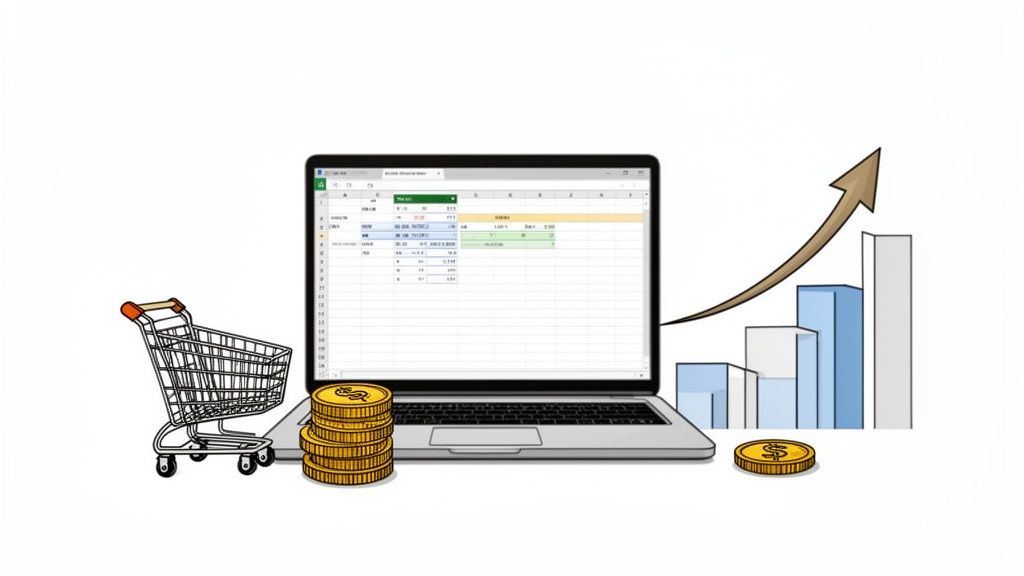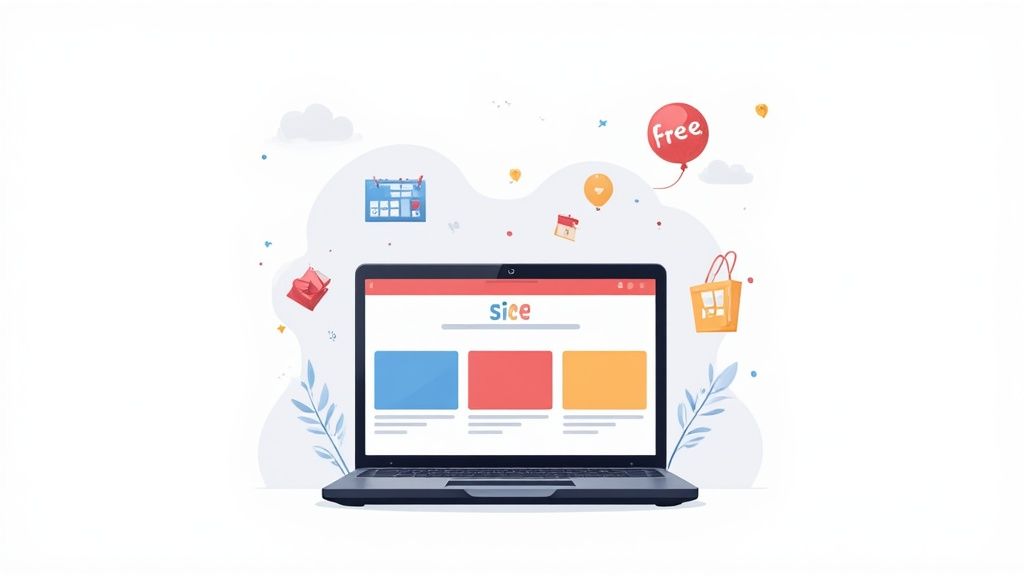

It might be difficult to decide which eCommerce platform to start with or convert an existing online store to because there are so many of them, including Shopify, Woocommerce, BigCommerce, and Magento (or Adobe Commerce). Since Shopify is one of the most scalable, feature-rich, and rapidly expanding eCommerce platforms available today, it is increasingly the preferred choice. To keep on top of trends and maintain a competitive edge over rivals like Magento, Shopify, and Shopify Plus are updated frequently.
Why Migrate your store to Shopify from Magento
With how fast the platform has evolved over the past few years, it might be just the perfect time to migrate from Magento to Shopify. The Shopify platform is constantly expanding the large array of applications, add-ons, and features that are already accessible. This platform offers considerably more than rivals like Magento and enables merchants to provide a strong customer experience.
The platform offers fantastic prospects for global expansion and improved control over design aesthetics. Additionally, Shopify offers a rapid and extremely secure hosting provider infrastructure, so data is well-protected and can be downloaded and viewed right away. Because of this, switching from Magento to Shopify and Shopify Plus is a very effective investment in the expansion and growth of your online business. The number of Shopify stores is growing rapidly, according to BuiltWith's eCommerce platform usage data, whereas Magento is losing merchants as a whole.
Many retailers are switching from Magento to Shopify since it is considerably less expensive to maintain the store, forget patching and development costs are often lower.
How to Migrate to Shopify from Magento
Merchants must set up a Shopify account and select one of the pricing plans to start the first stage of the instructions to migrate Magento to Shopify. The more sophisticated plans will generally depend on the size and type of your business when choosing a plan or subscription. The primary price ranges include
- Basic Shopify ($29 per month)- best for new eCommerce businesses with occasional in-person sales.
- Shopify ($79 per month)- best for growing businesses already selling online such as Magento or in-store.
- Advanced Shopify ($299 per month)- best for scaling businesses with advanced reporting.
Visit this page or look at our pricing guide for more information on Shopify plans and pricing. If you run a big company with lots of sales and are thinking about switching from Magento to Shopify, Shopify Plus is the enterprise-grade option with the most functionality available. Learn more about the differences between the two subscriptions in our post on Shopify vs. Shopify Plus to decide which is best for your business.
Although moving away from Magento can seem very scary, it is entirely possible to do so smoothly and without any problems. We strongly advise you to hire a Shopify firm to handle this process if your business requires functionality that is not typical of an e-commerce store or deals with a lot of goods, collections, customers, or pages.
A summary of the migration procedure from Magento to Shopify is that it entails exporting all of the data from your Magento Store and importing it into Shopify. Products, collections, clients, blogs, users, and pages are all examples of data. Additional data that is attached to the earlier data, such as tags and metafields utilized in the store's basic functionality, may need to be improved. It's crucial to note that because Magento and Shopify are constructed differently, you cannot import the appearance and feel of your store into Shopify. You would need to select a Shopify theme or work with a company to create a unique Shopify theme from scratch.
Backup your Magento store
We strongly advise merchants to move slowly and carefully, as mistakes could be very expensive to your company. Making a database backup copy of your store is crucial before moving any data to migrate from Magento to Shopify, and we also advise you to take a media backup.
Using the sidebar of the Admin panel in the Magento platform, this is possible. You may access it by selecting 'System' > 'Tools' > 'Backups' from the menu. When moving from Magento to Shopify, backing up is essential to have a restore point in case anything goes wrong. During migration, you should concentrate on two essential points: minimizing the impact on your customers and having a thorough backup of everything in case something goes wrong.
Download the data import app for Shopify
The next step in switching from Magento to Shopify is to download and install a data-importing program after backing up your store. However, other types of data, such as blog posts, previous orders, and more, will need to use Shopify's API. The good news is that there are already apps available for you to use that do just that without you having to become or hire a Shopify developer. Shopify does indeed allow you to import some data directly through the platform, such as products. We suggest Matrixify, a software for mass import and export that lets you upload CSV or XML files and import items like products, collections, customers, discounts, orders, payouts, pages, blog entries, and page redirection.
The amount of data you want to import utilizing the system will determine how much the app costs. Usually, a free trial is offered. The preparation of your data in a manner that Matrixify can read and then integrate into Shopify is the only challenging aspect of utilizing the software; more on that later. Keep your home in order as a top priority to lessen the impact on your business. You won't regret deciding to go to Shopify, though!
Export data import from Magento
The following stages involve exporting your data from Magento so that you may start setting up the files that will be used to import it into Shopify using your import app or, of course, the Shopify dashboard. You will need, at the very least, information about your products, category pages, clients, information about prior orders, blog entries, pages, and page URLs. Fortunately, Magento has a bulk export tool that we advise using.
The Magento version you are running will determine the data export process. The actions you must take to use Magento 2 are outlined in this guide.
To export your data from Magento 2:
- In the "Admin" sidebar, access "System" > "Data Transfer" > "Export".
- In the "Export Settings" section, set "Entity Type" to "Products".
- Accept the default export file format checkbox of CSV.
- Scroll down and click "Continue" in the bottom right corner of the All exported files are in the /var/export folder. If the remote storage module is enabled, all exported files are in the /import_export/export folder. You may need to access the media folder via the hosting and domain name provider or FTP.
This part can be quite complicated therefore we do recommend you seek expert help if you don't feel comfortable - it's not something anyone without expertise can do.
Import data into Shopify
The first thing to note is that while Shopify does allow you to import some data for your store directly through the Shopify admin page, some data types are not supported and you will need to use a third-party app provider, like Matrixify, or the Shopify API to complete your import.
Whether you use a third-party app or not, the most crucial thing to keep in mind while transferring the same data into Shopify is making sure that it is error-free. If not, you run the danger of damaging your imports or bringing brand-new issues to Shopify, neither of which you want! While you can import customers and goods directly into Shopify's admin, you'll need to use your app or an API to import additional sorts of data. In some cases, Matrixify can re-arrange your data for you to save you time and effort! View their guide from Magento to Shopify here. Therefore, let's get started by importing each of the data types into Shopify!
How to import products from Magento into Shopify?
Due to Shopify's native product import capability, which requires only pressing the import button, importing products into the database is one of the easiest imports. You must upload a CSV file containing all of your product information, including images and options like weight, color, tax price, product price, discount price, market, SKU, manufacturer, shipping info, shipping price, product descriptions, money, and more to import products into Shopify. Making sure your CSV file adheres to Shopify's specifications for structure is the most difficult aspect of product importation. We advise you to read Shopify's well-documented import and export lesson and guide before starting an import.
Open your Magento export CSV file to import products into Shopify. At this point, you should rearrange and modify the data to make it consistent with the Shopify product import CSV template. Title, descriptions, categories, tags, variants, prices, image URLs, SEO data, and more are among the data you should import. Shopify will give you a confirmation once your file has been uploaded to let you know the import has been successful.
How to import collections & categories from Magento into Shopify?
Although you cannot natively import collections into Shopify through the dashboard, you may build collections through the product import process, and Shopify will generate collections as soon as you import a product. You might want to think about manually creating collections via the Shopify admin, depending on how many collections you currently have. If your items have been imported with the appropriate tags, for instance, you can create an automated collection that enables you to provide criteria to automatically add products to collections. For instance, you could say, "Add products with the tag "Men's Shoes"." We advise using your third-party software to generate the collections for you if you do have a lot of collections.
How to import blogs & pages from Magento into Shopify?
Although there isn't a native option to transfer pages and blogs into Shopify, it's crucial to think about migrating old material when switching from Magento to Shopify to avoid negative SEO effects on your store. You can import blogs and page content into Shopify using a variety of third-party apps from the Shopify app store, which is the ideal way to finish the migration process from eCommerce website entities.
However, you can use Shopify's online store 2.0 template editor to create additional content modules; you'd need to set this up after you've imported the majority of the content. It's important to note that Shopify's pages and blogging feature natively only allows a title and one single rich text field.
How to import customers from Magento into Shopify?
There is a native mechanism to import customer lists into Shopify's platform. However, it's crucial to know that you cannot transfer passwords into Shopify as they are encrypted outside of the platform, so you will need to invite customers to re-activate their accounts and create a new password. Their online instruction on how to import clients makes it incredibly simple.
If you have Shopify Plus, you can use the Bulk Inviter app to automatically contact each of your customers and ask them to select a new password. If not, you'll need to rely on a third-party source, like Invite Sender. If you only need to invite a small number of customers, you can do so manually using the Shopify admin.
How to import orders from Magento into Shopify?
There isn't a native way to import prior orders onto Shopify's platform. However, you can import previous orders into the platform using Matrixify or another third-party tool. You might want to import orders into Shopify for two reasons: first, so your customers can view their order history, and second, so you can view your customers' order histories right inside Shopify. As a result, you won't be able to submit and process refunds through Shopify for past payments or purchase information taken on Magento, including card location. It's vital to remember that you cannot import any payment-related information or order status into Shopify Payments.
How to import discounts from Magento into Shopify?
There isn't a natural option to import discounts into Shopify's platform. However, you can import previous orders into the platform using Matrixify or another third-party tool. Here is a guide from Matrixified on how to add discounts in large quantities to Shopify.
How to import and set up page URL redirects from Magento into Shopify?
You must control URL page redirects if you switch from one eCommerce platform to another, such as from Magento to Shopify, to preserve your SEO. Different eСommerce platforms frequently have unique URL structures, which means that the URL that buyers visit to view your products, etc., will change. Setting up page redirects that will automatically send customers to the new URL is crucial to avoid the dreaded 404. Not only will you lose sales, but you also run the risk of seeing your SEO rankings fall as Google will have to re-index your entire store, and previous rankings will simply direct customers to a 404.
How therefore can we reduce the effects of URL changes? Set up so-called 301 redirects, which are automatic URL redirects. Redirects can be manually set up in Shopify. While Matrixify does, Shopify does not provide a means to manually incorporate URL redirection. To offer a list of the new redirects, you will need to discover a technique to quickly collect a comprehensive list of all the URLs for your website.
We advise using a website crawling tool like Screaming Frog software as this can be time-consuming. After that, you can provide your updated version by updating URLs in bulk using a spreadsheet. One last crucial point to keep in mind is to make sure you use the canonical version of the URL, which is the primary URL by which sites should be visited. If you drive them to the non-main URL, you will confuse the crawlers. Take particular caution because Shopify, for instance, allows you to access pages using a variety of URL formats, such as /collection-name/product-name/ or merely /products/product-name/.
Designing your Shopify store
It's time for the last step—designing your new Shopify store—now that your store has been converted from Magento to Shopify and all of your data fields have been verified. The ability to more easily control aesthetics with a large selection of themes that can be tailored to fit the website's appearance and feel to your brand is one advantage of utilizing Shopify versus Magento. Designing your store to offer a distinctive customer experience is highly advised if you want to set it apart from the competition and eventually attract clients who will buy from you again and again.
Migrating from Magento to Shopify: Considerations
There are several things to consider before switching from Magento to Shopify. The extent of the movement must be determined by the merchants. Identifying the data that must be transferred, such as client information, inventory, and purchase history, is part of this process. It's also crucial to think about whether any Magento extensions or plugins will need to be swapped out for Shopify equivalents.
The mode of migration must be chosen next. employing a data migration tool, employing a migration service, or manually moving data are all possibilities for migration. Each technique has drawbacks and variables to take into account, such as the size of the store, the complexity of the data, and the required level of support. Other things to think about are:
Data Security: Throughout the relocation process, data security must be taken into account. This involves making sure that payment gateway accounts, shipping addresses, and client passwords are all moved safely.
Performance and Revenue: Performance and sales of the store are further factors. Make sure the migration doesn't hurt site performance or cause a loss of income.
Support Team: To help with the transfer process, Shopify has a strong support staff and offers tools like video tutorials and a help center. To ensure a smooth transition, it is crucial to make use of these resources.
Customer Data: To make sure that customers are not lost during the transition, customer data, including first and last names, phone numbers, postcodes, and email addresses, needs to be migrated appropriately.
Storefront: Additionally, the storefront must be transferred, including the URL, logo, and any discounts or special offers that were previously used with Magento.
Inventory and Stock: To guarantee that the store accurately reflects the items that are currently available, it is crucial to migrate the inventory and stock levels correctly.
Country and State: It is crucial to make sure that the migration appropriately represents the various delivery alternatives offered if the store operates in multiple nations or states.
Browser Compatibility: To make sure that the storefront works well in all browsers, the migration should be tested for compatibility with each browser.
Need help in the Magento to Shopify migration process?
While moving from Magento to Shopify has been made somewhat easier and more user-friendly by Shopify, there are still times when it can be difficult, especially if your current e-commerce store is large or has complex requirements. In these cases, you may need the assistance of specialized developers to export and import thousands of lines of the target data via the e-commerce platform's APIs to access the necessary resources. Importing metafields data & product reviews is something else we suggest you think about.
Ecorn is available to help you with any aspect of the Magento to Shopify migration procedure or the entire process. We are Shopify professionals who can assist you with everything from the technical data importing and exporting stages to the optimization of your Shopify store's content, adding subscriptions, or designing hard-coded pages and bespoke web design for your business to genuinely create a unique experience. To discuss and begin your migration project, or to ask any concerns concerning migration, get in touch with us. Larger stores can benefit from selecting a Shopify agency to assist with your migration for numerous reasons, and we are the ones who can help!
Both Magento and Shopify are popular platforms for building eCommerce websites, but there are several reasons why businesses might consider migrating from Magento to Shopify. Here are some of the main reasons:
- User-Friendly Interface: Shopify is often praised for its user-friendly interface. Even users without technical expertise can set up and manage a Shopify store. Magento, on the other hand, can be more challenging for users without technical backgrounds.
- Hosting and Maintenance: Shopify is a hosted platform, which means hosting is included in the subscription fee. This reduces the burden of managing and maintaining servers. Magento, especially the open-source version, requires businesses to handle their own hosting, which can lead to additional costs and maintenance responsibilities.
- Costs: The ongoing costs for Magento can be unpredictable, especially if you need customizations, extensions, or third-party integrations. There are also hosting and security costs to consider. Shopify has a more predictable monthly fee, although transaction fees might be a factor if you don't use Shopify Payments.
- Security: With Shopify, SSL certificates and PCI compliance are included, and security updates are automatically handled by Shopify. With Magento, especially the open-source version, the onus is on the business to ensure security measures are up to date.
- Updates: Shopify handles updates automatically, ensuring the platform remains up-to-date with the latest features and security patches. Magento users need to manually manage and implement updates, which can be complex and may cause issues if not done correctly.
- Extensions and Apps: While Magento has a vast library of extensions, they might require technical expertise to install and manage. Shopify's app store offers a wide range of apps that can be easily installed and integrated into the store.
- Performance: Shopify’s infrastructure is optimized for performance, ensuring fast loading times and minimal downtime. With Magento, the performance can be influenced by hosting, server configurations, and the specific setup of the Magento site.
- Support: Shopify provides 24/7 customer support, which can be a significant advantage for businesses that don't have a dedicated IT team. While Magento Commerce (the paid version) offers support, Magento Open Source users are mostly reliant on community support or hiring external experts.
- Scalability: Shopify is built to scale with businesses as they grow. Its infrastructure can handle spikes in traffic and transactions, especially during peak shopping seasons.
- Transition to SaaS (Software as a Service): Some businesses prefer the SaaS model because of its convenience, security, and reduced overhead. Shopify is inherently a SaaS platform, whereas Magento Open Source is not.
Despite the reasons listed above, the decision to migrate from Magento to Shopify should be made based on individual business needs, technical expertise, and long-term goals.









































































































